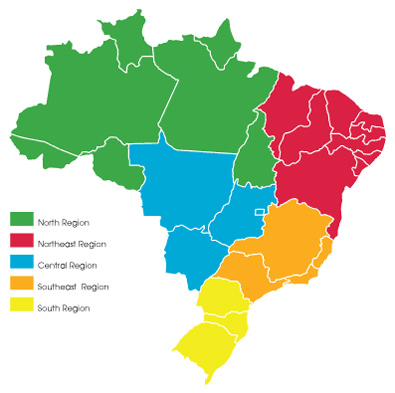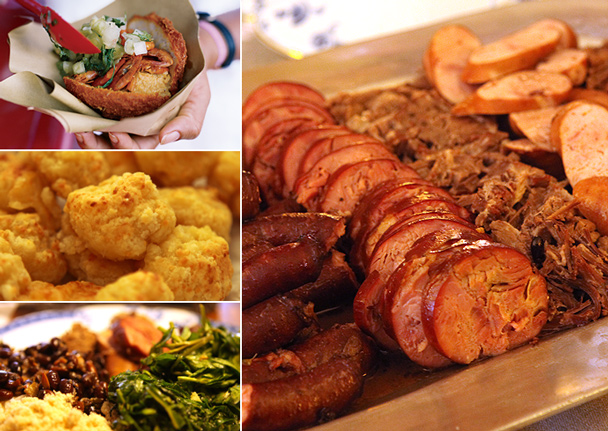If you were to travel to Brazil tomorrow not knowing much about the food culture, chances are you would pick the city of Rio de Janeiro to spend time in, and understandably so. It's a city set on a world-famous beach, surrounded by voluptuous mountains, a place where the sunsets are so perfect that people on the street are known to stop what they are doing just to look up and admire the spectacle. And of course, there are plenty of delicious places to eat in Rio, from the botecos serving beer and croquettes to the fashionable restaurant strip on the Rua Dias Ferreira in Leblon. But, beautiful though the city is, Brazil is so much more than Rio, especially when it comes to food. The regional cuisines of the north, northeast, central west, south, and southeast of this massive country are just as worthy of exploration, as each region has a personality of its own.
Brazilian food and culture can be best understood as a combination of native Indian, Portuguese, and African flavors, due to the leading roles these groups have played in the country's history: In the early 1500s the Portuguese arrived in this lush land to find a large indigenous population composed of an estimated 2,000 individual tribal groups. Over the next three centuries, international exploration, colonization, and the Atlantic slave trade brought some five million Africans to Brazil, along with many of their traditions. The past two centuries have seen the rise of ever-widening international influences on Brazilian culture, including the Germans who arrived in the first half of the 19th century, the Italians who arrived in the second half, plus Syrians, Lebanese, and, in the early 20th century, a major migration of Japanese immigrants. Brazil is now home to the second-largest Japanese population outside of Japan.
But despite the wild melting pot of cultures that fed the development of Brazilian cuisine, certain staple ingredients, dishes, and techniques are common to the food in almost every region. Most significantly, the universal role that manioc, or yucca, plays in the food of Brazil is comparable to that of rice in Japan, or corn in the United States.

So what dishes should the adventurous food lover look for outside Brazil's major cities? We've divided this huge 26-state country into five regions, shared a little bit of history, and made strong recommendations on what dishes are representative of the deep and varied cultural roots that animate these cuisines.
NORTH BRAZIL
Acre, Amazonas, Amapá, Pará, Rondônia, Roraima, and Tocantins
The food in the northern region is greatly influenced by the native Indians who inhabited the land long before the Portuguese arrived in the 1600s. As the cuisines of other regions evolved to encompass a variety of food cultures, the cuisine in the northern Amazon states as a whole remained the same, due largely to the wild surroundings and remote location. Much of what Brazilian food was at the time, and is now, is directly traceable to the Norte.
Take manioc, for example. Prior to the arrival of any outside influences, the indigenous population of the northern region was processing this root vegetable to make flour. These days manioc flour, or farinha, is eaten fried or toasted, and processed in a variety of other ways. In the northern regions manioc flour is used to make pirão, a thick, gelatinous concoction made up of finely ground farinha mixed with either fish or meat stock. Farinha is also toasted on the stovetop with a generous portion of butter, and called farofa. Sometimes it's served with sautéed onions, raisins, or with a scrambled egg. Manioc starch, or polvilho doce ("sweet" starch) and polvilho azedo ("sour" starch), is used to make crackers and breads like pão de queijo, also known as cheese bread.
But perhaps the best-known food product from this region is the açaí berry, the oft-proclaimed "superfood" that arrived in the U.S. food market about 10 years ago and has since managed to infiltrate beverage, smoothie, yogurt, and even liqueur flavors. Açaí, a cherry-size, dark-violet-colored fruit, is just as popular throughout Brazil. Go to a local juice bar in Rio and you'll find it served in a sorbet-like fashion after being blended with guaraná (a berry containing high levels of caffeine that is also used in Guaraná, the national soda of Brazil), and topped off with sliced bananas and granola. But açaí is just one of the native fruits the Amazon region is known for: The northern region is also home to the creamy white cupuaçu, saccharine-sweet and tangy graviola (soursop), the sweet-and-sour bacuri, the cashew fruit cajú, and the tart and berry-red acerola, available fresh at local juice spots, or as ice cream and Caipirinha flavors.
Hot pepper sauce, or pimenta, is another Amazon-derived specialty. There are more than a dozen varieties of Brazilian pimenta, ranging from malagueta to pimenta de cheiro, which translates to "the aromatic hot pepper."
Thanks to the overexposure of churrascarias—all-you-can-eat meat restaurants—Brazil is known mostly for its big meat-eating culture, but because of the vast water resources of the Amazon, it offers much more than that. According to Brazilian food historian Pedro Cavalcanti in his 2007 book A Pátria nas Panelas: História e Receitas da Cozinha Brasileira, if you wanted to taste a different Amazon-caught fish every single day, it would take you more than three years to accomplish the task. There are more than 1,200 species of fish, including tambaqui, a sweet-tasting firm white fish that many say tastes more like veal or pork, and which is known for having meaty ribs; pirarucu, which can be as long as 10 feet and is eaten fresh, smoked, or salted and dried like salt cod; and surubim, the Brazilian catfish, big and bony and often prepared na brasa (flame-grilled) or smoked. Belém, the riverside capital of the northern state of Pará, has long been a major portal to the Amazon region, and the fish markets there, in particular the historic Ver-o-Peso market, are known for their rich varieties of native fish.



 Pinterest
Pinterest


